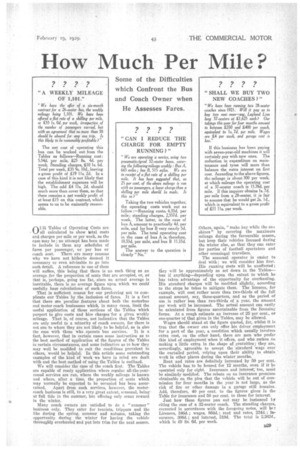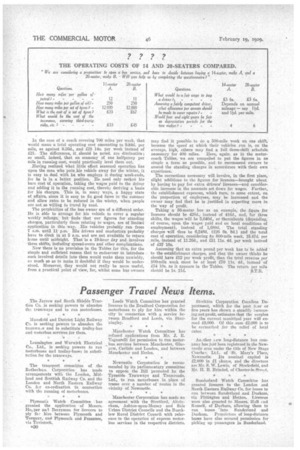How Much Per Mile ?
Page 135

Page 136

If you've noticed an error in this article please click here to report it so we can fix it.
OUR Tables of Operating Costs are
• all calculated to show total costs and charges per mile or per week, as the case may be ; no attempt has been made to include in them any schedules of fares per passenger, ■or per bus or coach seat. There are many reasons why we have not hitherto deemed it necessary or even advisable to go into such detail. A reference to one of them will suffice, this being that there is no such thing as an average for the proportion of seats that are occupied, or, as that is, perhaps, going too far' since an actual average is inevitable, there is no average figure upon which we could usefully base calculations of such fares.
That is sufficient reason for our preferring not to complicate our Tables by the inclusion of fares. It is a fact that there sere peculiar features about both the motorbus and motor coach businesses which, in many cases, limit the useful application of those sections of the Tables which purport to give costs and hire charges-for a given weekly mileage. That is, of course, not indicative that the Tables are only useful to a minority of coach owners, for there is not one to whom they are not likely to be helpful, as is also the case with those who operate bus services. It is a fact, however, that in certain cases some instruction as to the best method of application of the figures of the Tables in certain circumstances, and some indication as to how they may well be modified to suit the conditions prevalent in others would be helpful. In this article some outstanding examples of the kind of work • we have in mind are dealt with and the best method of using the Tables is outlined.
We will consider the ease of the coach first. The Tables are capable of ready application where regular all-the-yearround services are run, where the weekly mileage is known and where, after a time, the proportion of seats which may normally be expected to be occupied has beau ascer
tained. Apart from such services, however, the motorcoach business is still, to a very great extent, seasonal, being' at full tide in the summer, but offering only scant reward in the winter,
Many coach owners are satisfied to do a " summer " business only. They eater for tourists, trippers and the like during the spring, summer and autumn, taking the opportunity during the winter for having the vehicle thoroughly overhauled and put into trim for the next season. Others, again, "make hay while the sun shines" by covering the maximum mileage during the favourable season, but keep their vehicles licensed during the winter also, so that they can cater for parties of football spectators and other occasioaal travellers.
The seasonal operator is easier to deal with ; we will consider hint first. His running costs will be unaffected ; they will be approximately as set down in the Tables— less if anything—depending upon the extent to which he has taken advantage of the opportunity for overhauling. His standard charges will be modified slightly, according to the steps he takes to mitigate them. The licences, for example, will cost rather more than two-thirds of the full annual amount, say, three-quarters, and as the period of use is rather -less than two-thirds of a year, the amount per week will be increased. The actual amount can easily be. calculated from figures 'ascertainable from the licensing forms. At a rough estimate an increase of 25 per Cent., or one-quarter of that given in the Tables, may be allowed.
Wages should stand at the figure quoted, far, whilst it is true that the owner can only offer his driver employment for a part of the year, a condition which usually involves extra cost, on the other hand, there are men who prefer this kind of employment when it offers, and who reckon on making a little extra in the shape of gratuities; they are, .
accordingly, agreeable to accept the 'standard wage over the curtailed period, relying upon their ability to obtain work in other, places during the winter months. Rent and rates are definitely increased by 50 per cent. The vehicle has to be housed for 12 months, even if it be operated only for eight. Insurance and interest,too, must be similarly modified. The rebate on an insurance premium obtainable on the plea that the vehicle will be out of commission for four months in the year is not large, as the risk of fire or other damage in a garage still remains.. Add, therefore, 40 per cent. to the figures given in the Table for insurance and 50 per cent. to those for interest. Just how these figures pan out may be instanced hy citing the case of a 32-seater coach. The standing charges, corrected in accordance with the foregoing notes, will be : Licences, 346d.; wages, 884d.; rent and rates, 234d.; insurance, 308d.; and interest, 510d. The total is 2,262d., which is £9 8s. 6d. per week. in the case of a coach covering 700 miles per week, that would mean a total operating cost amounting to 0.84d. per mile, as against 9.26d., and £28 14e. Per week instead of The differences, it. should be noted, are diminutive ; so small, indeed, that an economy" Of one halfpenny per mile in running cost, would practically level them out.
Having realized what little effect seasonal operation has upon the man who puts his vehicle away for the winter, it is easy to. deal with he who employs it during week-ends, for he is in a better position. He . need only reckon his bare cost of operation, taking the wages paid to the driver and adding it to the running cost, thereby deriving a basis for his charges. This is, in many ways, a happy state of affairs, since it is easy to fix good fares in the summer and allow rates to be reduced in the winter, when people are not so willing to travel by road.
The perplexities of the bus owner are of a different order. He is able toarrange for his vehicle to cover a regular weekly Mileage; but finds that our figures for standing charges, particularly those relating to wages, are of limited application in this way. His vehicles probably run from 7 a.m. Until 11 p.m. His drivers and conductors probably have to cleck in at 5 g.m. and are not available to return home until midnight. That is a 19-hour day and involves three shifts, including spread-ovens and other complications.
Now there is no provision in the Tables for this, for the simple and sufficient reason that to endeavour to introduce such involved details into them would make them unwieldy, sa much so as to make it doubtful if they would be understood. Moreover, they would not really. be more useful, from a practical point of view, for, whilst some bus owners may find it possible to do a 500-mile week on one shift, because the speed at which their vehicles run is, on the average, high, others may find a full three-shift schedule
necessary for 400 miles. Here, again as in the motorcoach Tables, we are compelled to put the figures in as simple a form as possible, and to recommend owners to amend the standing charges in accordance with their own experience.
The corrections necessary will involve, in the first place, slight additions to the figures for licences—brought about by having to pay for extra drivers' licences—and considerable increase in the amounts set down for wages. Further,
• the establishment expenses, which turn, to some extent, on the proportion of employees, may be increased and the owner may feel that he is justified in expecting more in the way of profit.
Taking a 56-seater bus as an example, the figure for licences should be 420d., instead of 416d., and, for three shifts, the wages will be 5,040d., or thereabouts (depending, of course, upon the wages paid and on local conditions of employment), instead of 1,680d. The total standing charges will thus be 6,248d. (£26 OS. 8d,) and the total cost of operation, considering en 800-mile week, 15.47d. per mile, instead of 11.26d., and £51 us, 4d. per week instead of £37 10s.
Assuming that an extra pound per week has to be added ' to the establishment charges, and that the owner thinks he should have £12 per week profit, then the total revenue per 800-mile week must be at least £70 lie. 4d., instead of £54 10s. as it appears in the Tables. The return per mile.
should be Is. lid. S.T.R.




























































































































































































































